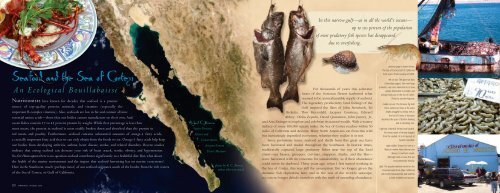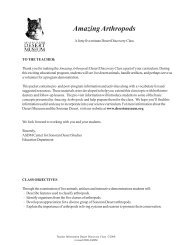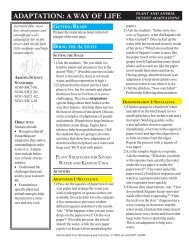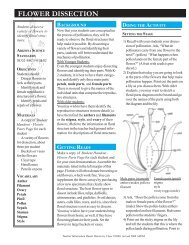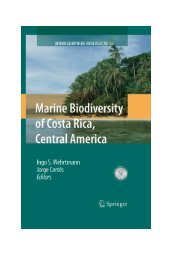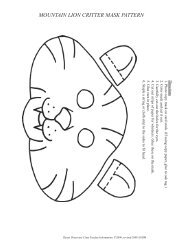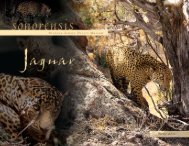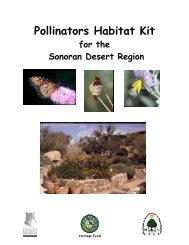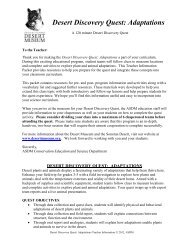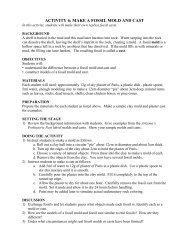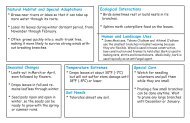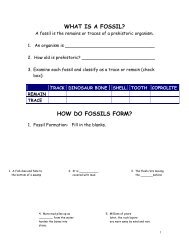Seafood and the Sea of Cortez - Arizona-Sonora Desert Museum
Seafood and the Sea of Cortez - Arizona-Sonora Desert Museum
Seafood and the Sea of Cortez - Arizona-Sonora Desert Museum
Create successful ePaper yourself
Turn your PDF publications into a flip-book with our unique Google optimized e-Paper software.
In this narrow gulf—as in all <strong>the</strong> world’s oceans—<br />
up to 90 percent <strong>of</strong> <strong>the</strong> population<br />
<strong>of</strong> most predatory fish species has disappeared<br />
due to overfishing.<br />
previous page: Lobster dinner;<br />
The <strong>Sea</strong> <strong>of</strong> <strong>Cortez</strong> (Gulf <strong>of</strong> California)<br />
from space. Photo courtesy <strong>of</strong> NASA.<br />
left cut-out: The giant sea bass<br />
(Stereolepis gigas), like most large<br />
predators, was once abundant but is now<br />
greatly diminished in number <strong>and</strong><br />
average body size in <strong>the</strong> <strong>Sea</strong> <strong>of</strong> <strong>Cortez</strong>.<br />
Photo by Jennifer Rupnow.<br />
An Ecological Bouillabaisse<br />
Nutritionists have known for decades that seafood is a premier<br />
source <strong>of</strong> top-quality protein, minerals, <strong>and</strong> vitamins (especially <strong>the</strong><br />
important B-complex vitamins). Also, seafoods are low in fat <strong>and</strong> contain all nine<br />
essential amino acids—those that our bodies cannot manufacture on <strong>the</strong>ir own. And,<br />
ocean fishes contain 17 to 25 percent protein by weight. While that percentage is less than<br />
most meats, <strong>the</strong> protein in seafood is more readily broken down <strong>and</strong> absorbed than <strong>the</strong> protein in<br />
red meats <strong>and</strong> poultry. Fur<strong>the</strong>rmore, seafood contains substantial amounts <strong>of</strong> omega-3 fatty acids,<br />
a crucially important fatty acid that we can only obtain from <strong>the</strong> foods we eat. Omega-3 fatty acids help keep<br />
our bodies from developing arthritis, asthma, heart disease, stroke, <strong>and</strong> related disorders. Recent studies<br />
indicate that eating seafood can decrease your risk <strong>of</strong> heart attack, stroke, obesity, <strong>and</strong> hypertension.<br />
So, for Homo sapiens <strong>the</strong>re is no question seafood contributes significantly to a healthful diet. But, what about<br />
<strong>the</strong> health <strong>of</strong> <strong>the</strong> marine environment <strong>and</strong> <strong>the</strong> impact that seafood harvesting has on marine ecosystems<br />
Here in <strong>the</strong> Southwest, much (perhaps most) <strong>of</strong> our seafood originates south <strong>of</strong> <strong>the</strong> border, from <strong>the</strong> rich waters<br />
<strong>of</strong> <strong>the</strong> <strong>Sea</strong> <strong>of</strong> <strong>Cortez</strong>, or Gulf <strong>of</strong> California.<br />
Richard C. Brusca,<br />
Senior Director,<br />
Science <strong>and</strong><br />
Conservation,<br />
<strong>Arizona</strong>-<strong>Sonora</strong><br />
<strong>Desert</strong> <strong>Museum</strong><br />
photos by R. C. Brusca,<br />
unless o<strong>the</strong>rwise noted<br />
For thous<strong>and</strong>s <strong>of</strong> years this saltwater<br />
heart <strong>of</strong> <strong>the</strong> <strong>Sonora</strong>n <strong>Desert</strong> harbored what<br />
seemed to be an inexhaustible supply <strong>of</strong> seafood.<br />
The legendary productivity (<strong>and</strong> fishing) <strong>of</strong> <strong>the</strong><br />
Gulf inspired <strong>the</strong> likes <strong>of</strong> John Steinbeck, Ed<br />
Ricketts, Thor Heyerdahl, Jacques Cousteau, Edward<br />
Abbey, Ofelia Zepeda, David Quammen, John Janovy, Jr.,<br />
<strong>and</strong> Ann Zwinger to explore <strong>and</strong> celebrate its natural wealth. With a watery<br />
surface <strong>of</strong> some 100,000 square miles, <strong>the</strong> <strong>Sea</strong> <strong>of</strong> <strong>Cortez</strong> reaches within 50<br />
miles <strong>of</strong> California <strong>and</strong> <strong>Arizona</strong>. Many North Americans eat from this wild<br />
but increasingly imperiled ecosystem, whe<strong>the</strong>r <strong>the</strong>y realize it or not.<br />
Since prehistoric times, seafood <strong>and</strong> shells from this great sea have<br />
been harvested <strong>and</strong> traded throughout <strong>the</strong> Southwest. In historic times,<br />
traditionally captured large predatory fishes near <strong>the</strong> top <strong>of</strong> <strong>the</strong> food<br />
chain—sea basses, groupers, corvinas, snappers, sharks, <strong>and</strong> <strong>the</strong> like—<br />
were harvested with no concerns for sustainability, as if <strong>the</strong>ir abundance<br />
could never be depleted. Thirty years ago, when I first started working in<br />
<strong>the</strong> <strong>Sea</strong> <strong>of</strong> <strong>Cortez</strong>, this was still <strong>the</strong> assumption. But no longer; given <strong>the</strong><br />
dramatic fish depletions here <strong>and</strong> in <strong>the</strong> rest <strong>of</strong> <strong>the</strong> world’s seascape,<br />
we can no longer delude ourselves with <strong>the</strong> myth <strong>of</strong> unending abundance.<br />
middle cut-out: The Panamic fig shell<br />
(Ficus ventricosa) lives at <strong>the</strong> same<br />
depths dragged by shrimp nets in<br />
<strong>the</strong> <strong>Sea</strong> <strong>of</strong> <strong>Cortez</strong>; it has been<br />
decimated by years <strong>of</strong> bottom trawling<br />
<strong>and</strong> is becoming rare.<br />
right top: Industrial shrimp boat bycatch.<br />
For every pound <strong>of</strong> shrimp dragged<br />
from <strong>the</strong> seabed, 10 to 40 pounds <strong>of</strong><br />
bycatch are killed.<br />
right middle: Shrimp for sale in a<br />
Mexican market. Most shrimp from<br />
Mexico is now farm raised,<br />
although rarely in ways that are<br />
environmentally friendly.<br />
right: The popular seafood market on <strong>the</strong><br />
Ensenada waterfront (Baja California)<br />
sells locally harvested fish <strong>and</strong> shellfish<br />
to both residents <strong>and</strong> tourists.<br />
20 sonorensis | winter 2009<br />
sonorensis | winter 2009 21
22 sonorensis | winter 2009<br />
above: Pre-Hispanic shell<br />
middens (dining<br />
refuse sites) can be<br />
found near virtually<br />
every coastal wetl<strong>and</strong><br />
in <strong>Sonora</strong>.<br />
Frilled venus clams<br />
(Chione undatella) <strong>and</strong> Panamic<br />
cockles (Trachicardium panamense) for sale<br />
today on <strong>the</strong> malecón at Kino Bay.<br />
Archeological excavations indicate <strong>the</strong>se<br />
species were also popular with Native<br />
American inhabitants along <strong>the</strong> <strong>Sea</strong> <strong>of</strong> <strong>Cortez</strong>.<br />
As a result <strong>of</strong> over-fishing, populations <strong>of</strong><br />
large predators are now a mere shadow<br />
<strong>of</strong> what <strong>the</strong>y were 40 years ago.<br />
In this narrow gulf—as in all <strong>the</strong> world’s oceans—up to 90 percent <strong>of</strong> <strong>the</strong><br />
population <strong>of</strong> most predatory fish species has disappeared due to overfishing.<br />
Today, all <strong>of</strong> <strong>the</strong> traditionally fished species from <strong>the</strong> <strong>Sea</strong> <strong>of</strong> <strong>Cortez</strong> have been<br />
overharvested to <strong>the</strong> point <strong>of</strong> collapse, or near-collapse, <strong>of</strong> <strong>the</strong>ir commercial<br />
fisheries. Traditionally preferred finfish have been so reduced in numbers that<br />
many Mexican fishers now take virtually any fish <strong>the</strong>y can catch, <strong>of</strong> any edible<br />
size. Decades <strong>of</strong> shrimp extraction have not only decimated shrimp populations,<br />
but also severely disrupted <strong>the</strong> seafloor ecosystem in much <strong>of</strong> <strong>the</strong> Gulf.<br />
In <strong>the</strong> nor<strong>the</strong>rn Gulf, <strong>the</strong> commercial finfish <strong>and</strong> wild-shrimp fisheries have<br />
essentially collapsed, <strong>and</strong> tourists in beach towns like Puerto Peñasco (Rocky<br />
Point) are now just as likely to be served cod or pollock, shipped frozen from<br />
Alaska or Europe, as a fresh local fish. Species once regarded as “trash fish” or<br />
“bycatch”—such as triggerfish, parrotfish, <strong>and</strong> skate—are now routinely sold in<br />
<strong>and</strong> restaurants. How did we get here <strong>and</strong> what can we do about it<br />
Ancient harvests from <strong>the</strong><br />
What were early inhabitants <strong>of</strong> <strong>the</strong> Gulf’s desert coastlines consuming, <strong>and</strong><br />
are those edible species still abundant Archeological excavations <strong>of</strong> prehistoric<br />
kitchen middens (dining-site trash dumps) indicate <strong>the</strong>y were feeding<br />
on shellfish, finfish, crabs, <strong>and</strong> sea turtles from coastal lagoons <strong>and</strong> <strong>the</strong> open<br />
coast, although <strong>the</strong>y also captured some terrestrial reptiles, mammals, <strong>and</strong><br />
birds that lived along <strong>the</strong> coast. They relied most heavily on clams <strong>and</strong> blue<br />
crabs, <strong>and</strong> a few fish species taken from coastal lagoons <strong>and</strong> estuaries. Thus,<br />
many <strong>of</strong> <strong>the</strong> seafood traditions that began in <strong>the</strong> <strong>Sea</strong> <strong>of</strong> <strong>Cortez</strong> in prehistoric<br />
time continue to this day in western Mexico, while o<strong>the</strong>rs, such as <strong>the</strong> ritual<br />
harvest <strong>of</strong> sea turtles, have all but disappeared as <strong>the</strong> animals <strong>the</strong>mselves<br />
have dramatically declined over <strong>the</strong> last century.<br />
above: Artisanal (panga) fishers on <strong>the</strong> coast <strong>of</strong> <strong>Sonora</strong>.<br />
cut-out: The Eastern Pacific pearl oyster (Pteria sterna) is <strong>the</strong> first species to be<br />
over-exploited in <strong>the</strong> <strong>Sea</strong> <strong>of</strong> <strong>Cortez</strong>, by Spanish colonists in search <strong>of</strong> pearls.<br />
The Ecological Depletion <strong>of</strong> <strong>the</strong><br />
levels <strong>the</strong> seafloor—<br />
<strong>the</strong> undersea equivalent<br />
<strong>of</strong> clear-cutting forests.<br />
Most wild shrimp are captured by<br />
bottom trawling, “dragging”<br />
with heavy equipment that<br />
above: The jumbo squid (Dosidicus gigas) is thought to have<br />
become abundant in <strong>the</strong> <strong>Sea</strong> <strong>of</strong> <strong>Cortez</strong> as top-predator finfish<br />
have been decimated by over-fishing—<strong>the</strong> squids are presumably<br />
moving in to fill <strong>the</strong> “empty niche.” Photo by A. Kerstitch<br />
right: Long-lines are one <strong>of</strong> <strong>the</strong> most destructive <strong>and</strong> indiscriminant fishing devices ever developed. They kill sea birds,<br />
marine mammals, <strong>and</strong> marine turtles, as well as having a high fish bycatch.<br />
Primary producers, algae <strong>and</strong> seaweeds that capture <strong>the</strong> sun’s energy<br />
at <strong>the</strong> base <strong>of</strong> marine food webs, are especially abundant in this semienclosed<br />
sea. This high primary productivity is driven by year-round<br />
strong solar input, upwelling <strong>of</strong> nutrient-rich bottom waters continuously<br />
drawn into <strong>the</strong> Gulf from <strong>the</strong> open Pacific, <strong>and</strong> good circulation.<br />
And, this productivity has supported one <strong>of</strong> <strong>the</strong> world’s most important<br />
concentrations <strong>of</strong> small oceanic fishes (such as anchovies, sardines,<br />
<strong>and</strong> mackerels), which in turn has provided critically important food<br />
sources for larger predatory fishes, jumbo squid, sea birds, marine<br />
mammals, <strong>and</strong>, eventually, humans. Beginning in <strong>the</strong> 1930s, however,<br />
a strong commercial fishery developed in this rich marine ecosystem,<br />
with some regrettable ecological impacts.<br />
Remember John Steinbeck’s little gem <strong>of</strong> a novel, The Pearl The<br />
first fishery in <strong>the</strong> <strong>Sea</strong> <strong>of</strong> <strong>Cortez</strong> to be over-fished was <strong>the</strong> pearl oyster<br />
fishery <strong>of</strong> <strong>the</strong> La Paz-Cape Region, which drew Spanish colonists to <strong>the</strong><br />
area in <strong>the</strong> 1600s <strong>and</strong> 1700s. Today, every commercial species in <strong>the</strong><br />
Gulf is probably overfished, except perhaps jumbo squid, which only<br />
recently arrived in <strong>the</strong> Gulf <strong>of</strong> California in numbers large enough to<br />
harvest. Artisanal fishers today take about 80 species <strong>of</strong> finfish <strong>and</strong><br />
shellfish, using long-lines, gillnets, cast nets, hook-<strong>and</strong>-line, pots, <strong>and</strong><br />
traps. An estimated 50,000 artisanal fishers operate 25,000 pangas in<br />
<strong>the</strong> Gulf today. And, ano<strong>the</strong>r 10,000 fishers work on some 1,280 industrial<br />
boats. Gulf waters are also subjected to fishing pressure from<br />
sportfishing by American tourists.<br />
Today, <strong>the</strong> most important species for artisanal fishers are shrimp,<br />
jumbo squid, <strong>and</strong> clams. For <strong>the</strong> industrial fishery, <strong>the</strong> Pacific (or Monterey)<br />
sardine is <strong>the</strong> most important species, followed by shrimp, tuna, <strong>and</strong> squid.<br />
As traditionally sought large predatory fish <strong>and</strong> shrimp have dwindled,<br />
industrial fishers have shifted increasingly to sardines <strong>and</strong> jumbo squid.<br />
The shift in primary target species has had significant socioeconomic<br />
impacts, but it could have even more pr<strong>of</strong>ound ecological repercussions.<br />
Sardines <strong>and</strong> anchovy, <strong>and</strong> jumbo squid, are key elements <strong>of</strong> <strong>the</strong> Gulf’s<br />
oceanic ecosystem. They represent species very near <strong>the</strong> bottom <strong>and</strong> top<br />
<strong>of</strong> <strong>the</strong> oceanic food chain, respectively. Their population sizes have direct<br />
effects on <strong>the</strong> rest <strong>of</strong> <strong>the</strong> food web, including <strong>the</strong> reproductive success <strong>of</strong><br />
seabirds. There is a real danger that <strong>the</strong>ir over-exploitation could result<br />
in fundamental changes in <strong>the</strong> oceanic ecosystem.<br />
sonorensis | winter 2009 23
More than one-third <strong>of</strong> <strong>the</strong> seafood<br />
consumed in <strong>the</strong> world<br />
is now farm raised.<br />
cut-out: The increasingly rare regal murex<br />
(Chicoreus regius) is a large, beautiful snail<br />
consumed locally in <strong>the</strong> Gulf. This species is<br />
<strong>of</strong>ten brought up in shrimp trawls <strong>and</strong> o<strong>the</strong>r<br />
bottom nets; <strong>the</strong> shells end up in curio shops.<br />
right: Gill net from a panga fisher,<br />
with bycatch <strong>of</strong> snails <strong>and</strong> crabs.<br />
Unsustainable fishing,<br />
bottom trawling, <strong>and</strong> environmentally<br />
unfriendly<br />
shrimp farming are perhaps<br />
<strong>the</strong> most serious<br />
threats to <strong>the</strong> ecological integrity <strong>of</strong> <strong>the</strong> <strong>Sea</strong> <strong>of</strong> <strong>Cortez</strong> today. As a result <strong>of</strong><br />
over-fishing, populations <strong>of</strong> large predators are now a mere shadow <strong>of</strong><br />
what <strong>the</strong>y were 40 years ago. The devastated populations include sea<br />
basses <strong>and</strong> groupers, sharks, some snappers, <strong>and</strong> even some jacks. Due<br />
to overfishing, some spawning aggregations <strong>of</strong> <strong>the</strong>se <strong>and</strong> o<strong>the</strong>rs large<br />
species—especially <strong>the</strong> goliath grouper <strong>and</strong> giant sea bass—may have<br />
entirely disappeared from <strong>the</strong> Gulf.<br />
Many less visible invertebrate species, also once-abundant, are also<br />
now rare here. Most wild shrimp are captured by bottom trawling, “dragging”<br />
with heavy equipment that levels <strong>the</strong> seafloor—<strong>the</strong> undersea equivalent<br />
<strong>of</strong> clear-cutting forests. The heavy chains on traditional trawl nets dig<br />
15 to 30 centimeters into <strong>the</strong> seabed. For every kilogram <strong>of</strong> wild shrimp<br />
trawled, 10 to 40 kilos <strong>of</strong> additional bycatch is killed! Shrimp trawlers produce<br />
an inordinate percentage <strong>of</strong> <strong>the</strong> global bycatch—capturing less than<br />
two percent <strong>of</strong> <strong>the</strong> world’s seafood by weight, but one-third <strong>of</strong> <strong>the</strong> world’s<br />
bycatch. Worldwide, every year an estimated 150,000 endangered sea turtles<br />
are caught <strong>and</strong> dragged in shrimp nets until <strong>the</strong>y drown. Shrimp<br />
trawlers kill more sea turtles than all o<strong>the</strong>r causes combined.<br />
Richard C. Brusca, Ph.D.<br />
Senior Director, Science<br />
<strong>and</strong> Conservation,<br />
<strong>Arizona</strong>-<strong>Sonora</strong><br />
<strong>Desert</strong> <strong>Museum</strong><br />
Almost everyone loves shrimp, <strong>and</strong> almost every restaurant has at least one shrimp dish<br />
on <strong>the</strong>ir menu. But, <strong>the</strong> large shrimps typically marketed as “jumbo shrimp,” “Gulf shrimp,”<br />
or “Guaymas shrimp” are some <strong>of</strong> <strong>the</strong> most unsustainably harvested seafoods in <strong>the</strong><br />
world. So, what is a shrimp-loving consumer to do Well, here’s <strong>the</strong> deal.<br />
First <strong>of</strong> all, shrimp come in two varieties. The big boys (“jumbo shrimp”) belong<br />
to a group known as <strong>the</strong> penaeid shrimps–technically, <strong>the</strong> Dendrobranchiata. The smaller<br />
shrimps, an inch or less in length <strong>and</strong> usually marketed as “bay shrimp,” “rock<br />
shrimp,” “nor<strong>the</strong>rn shrimp,” or “salad shrimp,” belong to a group known as <strong>the</strong><br />
caridean shrimps (technically, <strong>the</strong> Caridea). They are all crustaceans, but <strong>the</strong> two<br />
groups are only distantly related.<br />
No need to worry about <strong>the</strong> small shrimp; <strong>the</strong>y are by <strong>and</strong> large sustainably harvested.<br />
But jumbo shrimp is ano<strong>the</strong>r story altoge<strong>the</strong>r. Traditionally, <strong>the</strong>y are trawled from <strong>the</strong><br />
seabed with gigantic nets—a process that literally destroys <strong>the</strong> seabed <strong>and</strong> all <strong>the</strong> life that<br />
lives <strong>the</strong>re. Bottom trawling for shrimp is <strong>the</strong> most destructive fishing practice on Earth. In<br />
<strong>the</strong> United States <strong>the</strong>re are regulations that require shrimp fishers to use better designs <strong>of</strong><br />
bottom trawls, so <strong>the</strong> damage from U.S. trawlers is somewhat less than seen in most <strong>of</strong> <strong>the</strong><br />
rest <strong>of</strong> <strong>the</strong> world. Even so, <strong>the</strong>y still cause an unacceptable level <strong>of</strong> seafloor damage. One<br />
fishing operation in <strong>the</strong> <strong>Sea</strong> <strong>of</strong> <strong>Cortez</strong> (Pesquera Delly), has been trying to lead <strong>the</strong> way in<br />
Mexico by using <strong>the</strong>se less-destructive net designs; however, <strong>the</strong> future <strong>of</strong> this effort is<br />
left previous page: Gulf cleaner shrimp (Lysmata californica); above: Shrimp in fish market; Industrial shrimp boat bycatch; Coastal mangrove lagoons are critical nursery habitats for commercial shrimps.<br />
unclear. So, right now, <strong>the</strong> only good choice for wild-caught jumbo shrimp is <strong>the</strong> artisanal shrimp<br />
fishery <strong>of</strong> Mexico’s <strong>Sea</strong> <strong>of</strong> <strong>Cortez</strong>, which uses small boats (pangas) powered with outboard<br />
motors, <strong>and</strong> floating nets ra<strong>the</strong>r than bottom trawls. However, since <strong>the</strong>re is not yet a certification<br />
process that tells consumers <strong>the</strong> origin <strong>of</strong> <strong>the</strong> Mexican shrimp sold in our markets, it is best<br />
to avoid all Mexican shrimp, <strong>and</strong> also all U.S. wild-caught shrimp.<br />
The alternative to wild-caught shrimp is farmed shrimp. Almost all shrimp farming takes<br />
place in ear<strong>the</strong>n lagoons dredged along coastlines in <strong>the</strong> world’s tropics, where environmental<br />
regulations are typically weak or unenforced. Coastal environmental impacts are especially<br />
high in Sou<strong>the</strong>ast Asia, e.g., Thail<strong>and</strong>, Vietnam, <strong>and</strong> Bangladesh. (These are <strong>the</strong> only three<br />
countries <strong>of</strong> origin I saw on a recent frozen-shrimp search at my local Trader Joe’s market!).<br />
Endangered habitats such as mangrove forests are being destroyed or degraded in all <strong>of</strong> <strong>the</strong><br />
tropical countries where shrimp farming is taking place. And, once <strong>the</strong> shrimp ponds are in<br />
place, <strong>the</strong> operations flush directly into <strong>the</strong> sea, polluting it with wastewater, a variety <strong>of</strong> chemicals<br />
(pesticides, antibiotics, powerful disinfectants), escaped exotic shrimp, <strong>and</strong> exotic strains<br />
<strong>of</strong> shrimp diseases that infest local wild populations.<br />
But, <strong>the</strong>re’s good news. U.S. shrimp farmers must adhere to strict regulations that circumvent<br />
most <strong>of</strong> <strong>the</strong> above problems. For example, U.S. shrimp farms are not allowed to drain<br />
directly into <strong>the</strong> sea. And, more <strong>and</strong> more U.S. farms are using largely vegetable-based feeds<br />
that produce shrimp at close to a 1:1 ratio <strong>of</strong> fish-food to shrimp production, as opposed to<br />
fish pellets made from wild-caught fish, requiring a 3:1 ratio (an actual net loss from <strong>the</strong> sea). A<br />
fine example <strong>of</strong> good shrimp farming practices is <strong>the</strong> <strong>Desert</strong> Sweet Shrimp Farm in Gila Bend,<br />
<strong>Arizona</strong> (www.desertsweetshrimp.com). In Mexico, in just <strong>the</strong> past few years, new federal <strong>and</strong><br />
state regulations on shrimp farming have also been improving <strong>the</strong> situation. Some farms are<br />
For now <strong>the</strong> consumer’s best choice for sustainably produced<br />
jumbo shrimp is U.S. farm-raised.<br />
moving inl<strong>and</strong>, away from <strong>the</strong> fragile coastal environment, <strong>and</strong> in <strong>Sonora</strong> <strong>the</strong>se new shrimp<br />
farms <strong>of</strong>ten use l<strong>and</strong> that was long-ago ruined by too many years <strong>of</strong> intensive agriculture—barren<br />
l<strong>and</strong> is thus being recycled <strong>and</strong> put to good use. These inl<strong>and</strong> shrimp ponds still drain to <strong>the</strong><br />
sea, but <strong>the</strong> long canals (up to several kilometers) quickly develop a natural flora <strong>and</strong> fauna <strong>of</strong><br />
<strong>the</strong>ir own that helps to “filter” <strong>the</strong> discharge water before it reaches <strong>the</strong> coast. A good example<br />
<strong>of</strong> <strong>the</strong>se improved practices in Mexico is <strong>the</strong> La Borbolla shrimp farm, south <strong>of</strong> Kino Bay. La<br />
Borbolla has roughly a 1:1 ratio <strong>of</strong> fish-food to shrimp production, <strong>and</strong> can produce 25 to 35<br />
shrimp per square meter <strong>of</strong> pond. In 2008, <strong>the</strong> operation produced over two million pounds<br />
<strong>of</strong> Pacific white shrimp. But, <strong>the</strong>se kinds <strong>of</strong> shrimp farms are still rare in Mexico.<br />
So, for now <strong>the</strong> consumer’s best choice for sustainably produced jumbo shrimp is U.S.<br />
farm-raised. Hopefully, in <strong>the</strong> near future Mexican farmed shrimp will be equally sustainably<br />
produced. Sticking to conscientious choices will be a challenge for shrimp-lovers, but it is one<br />
we must confront.<br />
24 sonorensis | winter 2009 sonorensis | winter 2009 25
Is Aquaculture <strong>the</strong><br />
More than one-third <strong>of</strong> <strong>the</strong> seafood consumed in <strong>the</strong> world is now farm<br />
raised. Aquaculture has <strong>the</strong> potential to relieve pressures on declining wild<br />
seafood populations <strong>and</strong> create waste-free sustainable production—if it is<br />
done right. Unfortunately, this rarely happens, especially in <strong>the</strong> developing<br />
world (where most <strong>of</strong> our farmed seafoods originate). Most <strong>of</strong> <strong>the</strong><br />
world’s saltwater farming (mariculture) actually threatens wild fish stocks<br />
<strong>and</strong> disrupts or destroys natural habitats.<br />
The cultivation <strong>of</strong> carnivorous fish <strong>and</strong> shellfish (e.g., salmon, shrimp)<br />
has traditionally depended on catching wild fish to feed <strong>the</strong>m, <strong>and</strong> <strong>the</strong>se<br />
farms rely on huge quantities <strong>of</strong> wild-caught seafood. It can take over<br />
three kilos <strong>of</strong> wild-caught fish to raise one kilo <strong>of</strong> farmed salmon or<br />
shrimp, resulting in a net loss <strong>of</strong> fish from <strong>the</strong> sea. Today, about a quarter<br />
<strong>of</strong> all seafood caught in <strong>the</strong> wild is converted into fishmeal to feed<br />
farmed fish <strong>and</strong> shrimp.<br />
In addition, farmed fish <strong>and</strong> shrimp, whose place <strong>of</strong> origin is typically<br />
not local, frequently escape into <strong>the</strong> sea, polluting <strong>the</strong> gene pools <strong>of</strong> native<br />
species <strong>and</strong> introducing exotic diseases. For all <strong>the</strong>se reasons, marine<br />
species that are low in <strong>the</strong> food chain <strong>and</strong> subsist on a plant diet (herbivores)<br />
<strong>and</strong> will breed in captivity (e.g., catfish, trout, tilapia), are <strong>the</strong> best<br />
options for aquaculture.<br />
The first commercial shrimp farms in <strong>the</strong> <strong>Sea</strong> <strong>of</strong> <strong>Cortez</strong> were constructed<br />
in coastal <strong>Sonora</strong> in <strong>the</strong> 1980s. As <strong>of</strong> 2007, more than 150 shrimp<br />
farms had been built on <strong>the</strong> <strong>Sonora</strong> shoreline alone, covering an area <strong>of</strong><br />
100,000 hectares. Today, Mexico is <strong>the</strong> second largest producer <strong>of</strong> farmraised<br />
shrimp in <strong>the</strong> Western Hemisphere, but by <strong>the</strong> Mexican government’s<br />
own reckoning a few years ago, few <strong>of</strong> <strong>the</strong> shrimp farms gain high<br />
marks for sustainable practices.<br />
In Mexico, shrimp are typically raised in dirt ponds bulldozed out <strong>of</strong><br />
coastal habitat. Until very recently, <strong>the</strong>se sites were typically placed in or<br />
next to critically important coastal wetl<strong>and</strong>s, threatening habitat <strong>and</strong> rare<br />
or endemic marsh plants. Many <strong>of</strong> <strong>the</strong> Gulf’s mangrove forests <strong>and</strong> tidal<br />
Avoid <strong>the</strong>se seafoods, at least for now. They come from sources that are overfished or<br />
are caught or farmed in ways that harm o<strong>the</strong>r marine life or <strong>the</strong> environment.<br />
Chilean sea bass/toothfish*, corvina, groupers*, king crab (imported),<br />
mahi mahi/dolphinfish (imported), marlin, monkfish, orange roughy*,<br />
red snapper, salmon (farmed, Atlantic), sharks*, shrimp (all wild-caught, all imported),<br />
spiny lobster (Caribbean), swordfish (imported), totoaba,<br />
tuna (all tuna species caught by longline)*, tuna (bluefin, caught by any method)*<br />
* Limited consumption also advised due to concerns about mercury or o<strong>the</strong>r contaminants.<br />
Best Choices: These fish are abundant, well managed,<br />
<strong>and</strong> caught or farmed in environmentally friendly ways.<br />
Arctic char (farmed), barramundi (U.S. farmed), bay scallops (farmed),<br />
catfish (U.S. farmed), clams (farmed), cod (Alaska line caught)*,<br />
crab: dungeness, stone, king, blue (U.S.), flounder <strong>and</strong> sole (Pacific U.S.),<br />
halibut: Pacific, herring: Atlantic/sardines,<br />
lobster (wild-caught from Pacific Baja* <strong>and</strong> Maine), mahi mahi/dolphinfish (U.S.),<br />
mussels (farmed), octopus, oysters, pollock (Alaska wild-caught),<br />
rainbow trout (U.S. farmed), salmon (Alaska wild-caught), shrimp (U.S. farmed), squid,<br />
striped bass (farmed), swordfish (U.S.), tilapia (U.S. farmed),<br />
tuna (pole-caught albacore, bigeye, yellowfin, skipjack), yellowtail (U.S. farmed)<br />
*certified as sustainable to <strong>the</strong> Marine Stewardship Council st<strong>and</strong>ard (msc.org).<br />
marsh ecosystems have been severely damaged due to a variety <strong>of</strong><br />
coastal development, including <strong>the</strong> rapid growth <strong>of</strong> shrimp farms. In<br />
addition to habitat destruction, Mexico’s coastal shrimp farms usually<br />
flush to <strong>the</strong> open sea. In doing so, huge nutrient loads from uneaten<br />
food, shrimp feces, <strong>and</strong> dead shrimp wash out to <strong>the</strong> coast—along with<br />
antibiotics, added vitamins <strong>and</strong> hormones, o<strong>the</strong>r chemicals used in <strong>the</strong><br />
ponds, <strong>and</strong>, <strong>of</strong>ten, introduced (exotic) microorganisms from o<strong>the</strong>r regions<br />
that are imported with <strong>the</strong> shrimp that are introduced into <strong>the</strong> ponds.<br />
Today, U.S.-farmed shrimp is your best choice because it meets strict<br />
government environmental guidelines. Fortunately, <strong>the</strong> situation in<br />
Mexico is now beginning to improve <strong>and</strong> soon, hopefully, Mexican<br />
farm-raised shrimp will be on <strong>the</strong> recommended list. For now, one <strong>of</strong><br />
<strong>the</strong> best places to purchase seafood is your local Wal-Mart. In 2006, <strong>the</strong><br />
company made a pledge to America that <strong>the</strong>ir U.S. stores would sell only<br />
sustainably harvested seafoods, relying heavily on recommendations <strong>of</strong><br />
<strong>the</strong> Marine Stewardship Council <strong>and</strong> Aquaculture Certification Council.<br />
Because Wal-Mart is <strong>the</strong> world’s largest retail seller <strong>of</strong> seafood, this decision<br />
has had a powerful <strong>and</strong> positive impact on global seafood markets.<br />
In addition, <strong>the</strong> Walton Family Foundation provides hundreds <strong>of</strong> millions<br />
<strong>of</strong> dollars annually for marine conservation efforts; <strong>the</strong>y are especially<br />
active in protecting <strong>the</strong> Gulf <strong>of</strong> California.<br />
What it Being<br />
The rise <strong>of</strong> <strong>the</strong> conservation movement in Mexico over <strong>the</strong> past 20<br />
years has led to significant increased pressure on federal agencies, <strong>and</strong><br />
meaningful steps are now being taken to protect <strong>the</strong> <strong>Sea</strong> <strong>of</strong> <strong>Cortez</strong> for<br />
<strong>the</strong> future. Since <strong>the</strong> l<strong>and</strong>mark declaration <strong>of</strong> two biosphere reserves<br />
Consumer power is enormous! In restaurants,<br />
supermarkets, <strong>and</strong> fish markets, ask about <strong>the</strong> source<br />
<strong>of</strong> <strong>the</strong> seafoods you buy; ask if it is farmed or wild-caught<br />
(<strong>and</strong>, if caught, where <strong>and</strong> how it was caught).<br />
far left: Estero Soldado (San Carlos) is one <strong>of</strong> <strong>the</strong> last remaining mangrove wetl<strong>and</strong>s<br />
in <strong>Sonora</strong> that has not felt <strong>the</strong> impacts <strong>of</strong> shrimp farming.<br />
left: Oyster farm at Kino Bay. Most oyster farms in <strong>the</strong> Gulf are small scale,<br />
open water, sustainable operations.<br />
in northwestern Mexico in 1993—<strong>the</strong> Alto Golfo de California y Delta<br />
del Río Colorado, <strong>and</strong> <strong>the</strong> El Pinacate y Gran Desierto de Altar<br />
Biosphere Reserves—hard work <strong>and</strong> steady lobbying has resulted in <strong>the</strong><br />
establishment <strong>of</strong> 15 more protected areas on <strong>the</strong> Baja California peninsula<br />
<strong>and</strong> in <strong>the</strong> <strong>Sea</strong> <strong>of</strong> <strong>Cortez</strong>.<br />
Creating change in fisheries management has been harder. However,<br />
because <strong>of</strong> declining fisheries catches, pressure from environmental organizations,<br />
<strong>the</strong> rise <strong>of</strong> sustainable seafood initiatives, <strong>and</strong> new political leadership,<br />
things are starting to change. There is reason to believe that <strong>the</strong> government<br />
<strong>of</strong> President Felipe Calderón recognizes <strong>the</strong> need for better fisheries<br />
management. Some positive first steps are being taken. New federal<br />
<strong>and</strong> state laws in Mexico are establishing environmental controls over<br />
coastal aquaculture, including shrimp farming. New coastal wetl<strong>and</strong> protections<br />
are forcing shrimp farms inl<strong>and</strong>, away from sensitive coastlines, <strong>and</strong><br />
regulations on <strong>the</strong> import <strong>of</strong> exotic “seed” shrimp <strong>and</strong> on aquaculture pond<br />
discharges are now appearing. One <strong>of</strong> <strong>the</strong> best examples <strong>of</strong> sustainable mariculture<br />
are <strong>the</strong> oyster farms that have sprung up in most <strong>of</strong> <strong>Sonora</strong>’s coastal<br />
lagoons over <strong>the</strong> past 20 years or so; <strong>the</strong>se farms use no additives <strong>and</strong> do<br />
not pollute or negatively impact <strong>the</strong> environment.<br />
26 sonorensis | winter 2009 sonorensis | winter 2009 27
We don’t need to stop eating seafood;<br />
people lived in a balance<br />
with <strong>the</strong> sea for thous<strong>and</strong>s <strong>of</strong> years, until only recently.<br />
top: Floating tuna farms <strong>of</strong>f <strong>the</strong> Pacific coast <strong>of</strong><br />
Baja California.<br />
middle left: <strong><strong>Sea</strong>food</strong> market, Baja California.<br />
What Can<br />
Because we are now aware <strong>of</strong> <strong>the</strong> depletion <strong>of</strong> <strong>the</strong> seas, we have a<br />
greater responsibility, not just for <strong>the</strong> sake <strong>of</strong> <strong>the</strong> marine environment but<br />
also for our own selfish interests, to pay attention to <strong>the</strong> sources <strong>of</strong> our<br />
seafood. And we now have a wealth <strong>of</strong> information about what to buy<br />
<strong>and</strong> what to avoid to help prevent <strong>the</strong> overharvesting <strong>and</strong> degradation <strong>of</strong><br />
<strong>the</strong> <strong>Sea</strong> <strong>of</strong> <strong>Cortez</strong> <strong>and</strong> o<strong>the</strong>r ocean environments.<br />
In restaurants, supermarkets, <strong>and</strong> fish markets, ask about <strong>the</strong> source<br />
<strong>of</strong> <strong>the</strong> seafoods you buy; ask if it is farmed or wild-caught (<strong>and</strong>, if caught,<br />
where <strong>and</strong> how it was caught). As evidenced by <strong>the</strong> history <strong>of</strong> tuna fishing,<br />
consumer power is enormous. Express your interest in sustainably<br />
harvested products, <strong>and</strong> don’t buy finfish <strong>and</strong> shellfish whose populations<br />
are being decimated. The status <strong>of</strong> <strong>the</strong>se fish may change over time,<br />
so keep up-to-date via websites like those at <strong>the</strong> end <strong>of</strong> this article. In <strong>the</strong><br />
meantime, use <strong>the</strong> lists on <strong>the</strong>se pages to guide your purchases. The<br />
Marine Stewardship Council lists supermarkets <strong>and</strong> restaurants worldwide<br />
that carry <strong>the</strong> council’s sustainable certification, as well as sustainable<br />
seafood sources for your business.<br />
middle right: Gulf giant hermit crab (Petrochirus<br />
californiensis).<br />
left: <strong>the</strong> long-beaked common dolphin<br />
(Delphinus capensis) occurs in pods <strong>of</strong> up to<br />
hundreds <strong>of</strong> individuals in <strong>the</strong> <strong>Sea</strong> <strong>of</strong> <strong>Cortez</strong>.<br />
They are frequently killed by drowning in gill<br />
nets that indiscriminately kill anything that gets<br />
trapped in <strong>the</strong>ir mesh.<br />
For more comprehensive coverage<br />
on sustainable seafood choices, visit:<br />
<strong>Arizona</strong>-<strong>Sonora</strong> <strong>Desert</strong> <strong>Museum</strong><br />
(desertmuseum.org/center/seafood.php)<br />
Monterey Bay Aquarium <strong><strong>Sea</strong>food</strong> Watch Program<br />
(mbayaq.org/cr/cr_seafoodwatch)<br />
Marine Stewardship Council: (www.msc.org)<br />
Oceans Alive (oceansalive.org)<br />
<strong><strong>Sea</strong>food</strong> Choices Alliance (seafoodchoices.com)<br />
We don’t need to stop eating seafood; people lived in a balance<br />
with <strong>the</strong> sea for thous<strong>and</strong>s <strong>of</strong> years, until only recently. Fish<br />
from <strong>the</strong> <strong>Sea</strong> <strong>of</strong> <strong>Cortez</strong>, our <strong>Sonora</strong>n <strong>Desert</strong> ocean, remains an<br />
excellent choice for local healthy food. But we need to better manage<br />
our harvests <strong>and</strong> our consumption to prevent catastrophic collapse<br />
<strong>of</strong> marine ecosystems.<br />
A Special<br />
to Sou<strong>the</strong>rn <strong>Arizona</strong><br />
Restaurateurs<br />
Please consider doing what <strong>the</strong> Ironwood Food Service’s restaurants<br />
do at <strong>the</strong> <strong>Desert</strong> <strong>Museum</strong>—make a pledge to serve only sustainable<br />
seafoods. It’s easy. Just dedicate your menu to seafoods<br />
in <strong>the</strong> “best choices” list in this issue <strong>of</strong> sonorensis (or <strong>the</strong> “best<br />
choices” listed by Monterey Bay Aquarium’s <strong><strong>Sea</strong>food</strong> Watch program).<br />
Delicious preparations are easy—think farmed bay scallops,<br />
Alaskan salmon <strong>and</strong> flounder, Pacific halibut, Maine or Baja<br />
lobster, U.S. mahi mahi, U.S. farmed shrimp <strong>and</strong> tilapia, <strong>and</strong> farmed<br />
mussels, oysters, <strong>and</strong> trout. In Monterey, California, over two<br />
dozen restaurants are now serving 100 percent sustainable<br />
seafoods. If <strong>the</strong>y can do it, so can <strong>Arizona</strong>. Go sustainable, <strong>and</strong> let<br />
<strong>the</strong> <strong>Desert</strong> <strong>Museum</strong> help promote your good work! S<br />
Suggested References:<br />
Brusca, R. C. (ed.). Biodiversity <strong>and</strong> Conservation in <strong>the</strong> Gulf <strong>of</strong> California. Tucson: UA<br />
Press/ASDM Press, 2010.<br />
Brusca, R. C., E. Kimrey, <strong>and</strong> W. Moore. <strong>Sea</strong>shore Guide to <strong>the</strong> Nor<strong>the</strong>rn Gulf <strong>of</strong><br />
California. Tucson: ASDM Press, 2004.<br />
Páez-Osuna, F., A. Garcia, F. Flores-Verdugo, L. P. Lyle-Fritch, R. Alonso-<br />
Rodríguez, A. Roque, <strong>and</strong> A. C. Ruíz-Fernández. Shrimp aquaculture development<br />
<strong>and</strong> <strong>the</strong> environment in <strong>the</strong> Gulf <strong>of</strong> California ecoregion.<br />
Marine Pollution Bulletin 46:806-816, 2003.<br />
Sala, E., O. Aburto-Oropeza, M. Reza, G. Paredes, <strong>and</strong><br />
L. G. López-Lemus. Fishing down coastal food webs in <strong>the</strong> Gulf <strong>of</strong> California.<br />
Fisheries 29(3):19-25, 2004.<br />
with mango-papaya relish<br />
Courtesy <strong>of</strong> Nick Ruman, Executive Chef,<br />
Ironwood Food Services,<br />
<strong>Arizona</strong>-<strong>Sonora</strong> <strong>Desert</strong> <strong>Museum</strong><br />
16 jumbo shrimp<br />
marinade<br />
4 tablespoons lime juice<br />
1 teaspoon pureed chipotle (no seeds)<br />
6 ounces pineapple juice<br />
2 ounces rum<br />
1 teaspoon minced garlic<br />
1 ounces prickly pear syrup<br />
1/2 teaspoon salt<br />
relish<br />
1/2 mango, diced<br />
1/2 papaya, diced<br />
1/2 green pepper, diced<br />
1/2 red pepper, diced<br />
1/3 red onion, diced<br />
2 ounces pineapple juice<br />
2 tablespoons lime juice<br />
2 tablespoons red wine vinegar<br />
1 teaspoon minced fresh ginger<br />
1 teaspoon minced garlic<br />
1/2 teaspoon salt<br />
optional – 1/2 seeded <strong>and</strong><br />
chopped serrano chili<br />
Shrimp is high in protein <strong>and</strong> vitamins B12 <strong>and</strong> D.<br />
1. Devein <strong>the</strong> shrimp by making a<br />
shallow slit down <strong>the</strong> back <strong>and</strong><br />
picking out <strong>the</strong> vein.<br />
2. Marinate shrimp on <strong>the</strong>ir skewers<br />
for 2 to 4 hours only, not more or<br />
<strong>the</strong> shrimp will get tough.<br />
3. Mix all relish ingredients <strong>and</strong><br />
let st<strong>and</strong> for 2 or more hours.<br />
4. Grill shrimp over medium,<br />
not hot heat, turning once,<br />
for 2 to 4 minutes on each side.<br />
Remove as soon as <strong>the</strong> outer skin has<br />
changed color from gray or bluish to<br />
orange or pinkish. Do not overcook!<br />
4. Put relish on plate <strong>and</strong><br />
top with grilled shrimp.<br />
Serves 3 to 4 people.<br />
Fried yam matchsticks<br />
make a nice garnish.<br />
28 sonorensis | winter 2009


